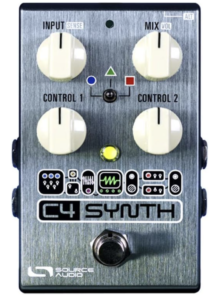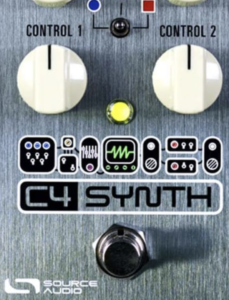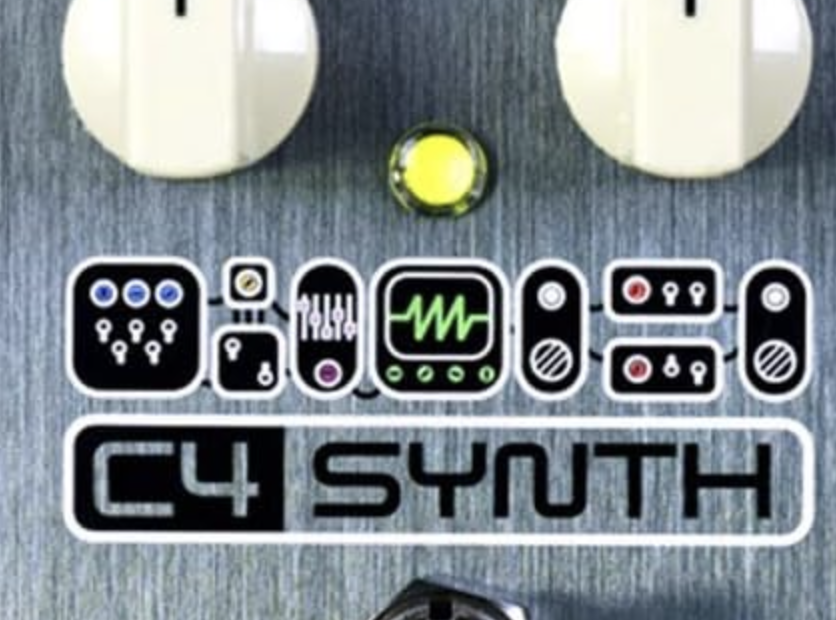The Source Audio C4 Synth is a versatile and powerful guitar pedal that offers a wide range of synth and modulation sounds for guitarists and bassists. It is manufactured by Source Audio, a company known for producing innovative and feature-rich effects pedals and audio equipment.
This pedal is in the same category of the synth pedals such as Mooer E7 and Boss SY-1. Here are some key features and capabilities of the Source Audio C4 Synth pedal:
Synth and Modulation Sounds
 The Source Audio C4 Synth pedal [buy here] is designed to transform your guitar or bass signal into a diverse range of synthesizer-like tones and modulations. It achieves this by utilizing advanced digital signal processing and multiple synth engine algorithms.
The Source Audio C4 Synth pedal [buy here] is designed to transform your guitar or bass signal into a diverse range of synthesizer-like tones and modulations. It achieves this by utilizing advanced digital signal processing and multiple synth engine algorithms.
These algorithms emulate different types of synthesizers and modulation effects, allowing you to explore an expansive sonic landscape beyond traditional guitar tones.
The pedal typically offers a selection of different synth engines, each modeling a specific type of synthesizer or sound generation method. These engines might include:
- Analog Synth: Replicates the warm, organic tones of classic analog synthesizers.
- FM Synth: Emulates Frequency Modulation synthesis, known for its complex and evolving timbres.
- Wavetable Synth: Generates evolving and dynamic sounds by sweeping through wavetables.
- Filter Modulation: Applies filter-based effects like wah, envelope filtering, and more.
- Octave and Pitch Effects: Produces octave-up and octave-down sounds, pitch bends, and glides.
- Arpeggiation and Sequencing: Generates sequenced patterns, arpeggiated melodies, and rhythmic textures.
Sound Shaping and Editing
The C4 Synth pedal [buy here] often provides an array of editable parameters for each synth engine. These parameters allow you to sculpt and customize your synth sounds to your liking. Depending on the engine, you might be able to adjust parameters such as oscillator type, filter cutoff, resonance, envelope settings, LFO (Low-Frequency Oscillator) modulation, and more. This level of control empowers you to create unique and evolving synth textures that suit your musical style.
To enhance user convenience, the pedal typically includes preset storage capabilities. This enables you to save your custom-created synth patches and recall them later. The ability to save presets is especially useful for live performances, studio recording, and quick sound changes.
Multiple Synth Engines
The pedal typically includes a range of synth engines or algorithms that you can select and modify to create different sounds. These engines might include analog-style synths, FM (Frequency Modulation) synths, wavetable synthesis, and more.
Read Also:
Roland GR-55 Guitar Synthesizer Review
Mooer E7: Polyphonic Guitar Synth Effects Pedal Review
Guitar Synthesizer: BOSS SY-1 Pedal
MOOER Acoustikar Acoustic Guitar Simulator Pedal
PRS SE Custom 24 Guitar Review
Jackson Custom Shop Exclusive SL2H-V Soloist guitar
Deep Editing
 Deep editing and presets are important features of the Source Audio C4 Synth pedal [buy here] that provide you with the ability to finely tweak and customize your synth sounds, as well as store and recall your favorite settings. These features contribute to the pedal’s versatility and usability in both live performances and studio settings. Here’s a closer look at deep editing and presets on the Source Audio C4 Synth pedal:
Deep editing and presets are important features of the Source Audio C4 Synth pedal [buy here] that provide you with the ability to finely tweak and customize your synth sounds, as well as store and recall your favorite settings. These features contribute to the pedal’s versatility and usability in both live performances and studio settings. Here’s a closer look at deep editing and presets on the Source Audio C4 Synth pedal:
Deep editing refers to the extensive level of parameter control and customization that the C4 Synth pedal offers. It allows you to dive into the details of each synth engine and sound effect to sculpt your desired tones. Here’s what deep editing typically entails:
- Parameter Control: The pedal provides access to a variety of adjustable parameters for each synth engine. These parameters might include oscillator settings (waveform, detuning), filter parameters (cutoff, resonance), envelope settings (attack, decay, sustain, release), LFO modulation parameters, and more.
- Real-Time Tweaking: You can make adjustments to these parameters in real-time, either using the pedal’s controls or via external expression pedals. This allows you to experiment and shape your sounds on the fly, making the pedal highly expressive and adaptable.
- Dynamic Modulation: Deep editing often includes the ability to modulate parameters dynamically. For example, you might assign an expression pedal to control filter cutoff or LFO rate, giving you hands-free control over sound modulation.
- Custom Sound Design: With deep editing, you can create your own unique synth patches that match your musical vision. You have the flexibility to design everything from classic synth tones to experimental and otherworldly soundscapes.
Expression Control
 Expression control is a versatile feature found in many effects pedals, including the Source Audio C4 Synth pedal. It allows you to manipulate various parameters of the pedal in real-time using an external expression pedal. This dynamic interaction can significantly enhance your playing experience and provide expressive control over your effects and sounds. Here’s a deeper look at expression control and its significance:
Expression control is a versatile feature found in many effects pedals, including the Source Audio C4 Synth pedal. It allows you to manipulate various parameters of the pedal in real-time using an external expression pedal. This dynamic interaction can significantly enhance your playing experience and provide expressive control over your effects and sounds. Here’s a deeper look at expression control and its significance:
Expression control involves connecting an external expression pedal to your effects pedal. The expression pedal typically has a foot-controlled rocking mechanism that generates a variable voltage signal based on its position. This signal is then sent to the effects pedal, which uses it to adjust specific parameters in response to your foot movement.
Expression control adds a new dimension to your playing by allowing you to manipulate effects parameters on the fly. Here’s why expression control is significant:
- Real-Time Modulation: Expression control enables you to change parameters dynamically while you play, creating evolving and expressive sounds. This is particularly useful for adding textures, swells, and other dynamic effects to your playing.
- Hands-Free Operation: With an expression pedal, you can adjust parameters without taking your hands off the guitar. This allows for seamless transitions between different sounds and effects during a performance.
- Sound Sculpting: Expression control lets you “perform” the effects, giving you the ability to shape and sculpt your sound in response to your musical intuition. It’s like adding an extra layer of expressiveness to your playing.
- Versatility: Different effects pedals allow you to control various parameters using an expression pedal. For example, on the Source Audio C4 Synth pedal, you might use expression control to adjust filter cutoff, LFO rate, pitch bend, or other parameters.
- Live Performance: Expression control is particularly valuable in live performances, as it allows you to interact with your effects in real-time, creating captivating and engaging performances.
Expression Control with the Source Audio C4 Synth
 On the Source Audio C4 Synth pedal [buy here], expression control can be used to modulate a range of parameters depending on the selected synth engine. For instance, you might use expression control to:
On the Source Audio C4 Synth pedal [buy here], expression control can be used to modulate a range of parameters depending on the selected synth engine. For instance, you might use expression control to:
- Sweep Filter Cutoff: Create sweeping filter effects by assigning the expression pedal to control the cutoff frequency of a resonant filter.
- Adjust LFO Rate: Modulate the speed of a Low-Frequency Oscillator (LFO) to create rhythmic modulation effects.
- Bend Pitch: Add pitch bend effects by using the expression pedal to raise or lower the pitch of your synth sounds.
The Source Audio C4 Synth’s compatibility with expression control adds an extra layer of creativity and playability, allowing you to explore new sonic territories and engage with your music in innovative ways.
Other Useful Features
- MIDI Capabilities: The pedal might have MIDI input and output, allowing you to integrate it into a MIDI setup for remote control, preset changes, and synchronization with other MIDI-enabled devices.
- Stereo Outputs: The C4 Synth pedal may feature stereo outputs, which can be used to create immersive and wide synth sounds when connected to stereo equipment or amplifiers.
- Neuro Desktop Editor and Mobile App: Source Audio often provides a desktop editor and a mobile app (Neuro Mobile App) that allows you to dive deep into the pedal’s parameters, create and share presets, and explore additional features and updates.
- USB Connectivity: The pedal may have a USB port for firmware updates and direct connection to a computer for editing and preset management.
- Quality and Durability: Source Audio is known for producing pedals with high build quality and robust construction, ensuring that the C4 Synth can withstand the demands of live performances and studio use.
